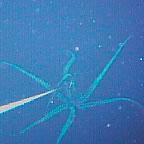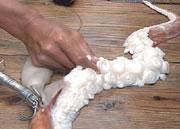 This rare, eight-metre long squid was lured into a photo by a simple fishing line.© T. Kubodera & K. Mori
This rare, eight-metre long squid was lured into a photo by a simple fishing line.© T. Kubodera & K. MoriThis is the first ever photograph of a giant squid in the wild. Japanese researchers snapped the eight-metre monster as it attacked their bait in the inky blackness almost a kilometre below the waves.
The giant squid, Architeuthis, is the largest invertebrate in the world. More than 580 individuals have been washed up on shorelines since the sixteenth century, giving marine biologists a good idea of their size and lifestyle. Some of the specimens have reached 18 metres in length, including tentacles, and weighed almost a tonne.
The animals are thought to be rare and live only at great depths, so living specimens have remained elusive.
Field of focus
 The squid lost an arm in a tangle with the camera. The suckers on the tentacle were still sucking when researchers hauled it on board.© T. Kubodera & K. Mori
The squid lost an arm in a tangle with the camera. The suckers on the tentacle were still sucking when researchers hauled it on board.© T. Kubodera & K. MoriThe photographs were taken by zoologist Tsunemi Kubodera of the National Science Museum, and Kyoichi Mori of the Ogasawara Whale Watching Association, both based in Tokyo. They used a 1,000-metre baited fishing line with a camera attached to record the close encounter in the deep.
Their images show a giant squid aggressively engulfing the bait at a depth of some 900 metres. During the encounter, which lasted more than four hours, the squid became entangled in the apparatus and eventually beat a retreat, leaving behind a 5.5-metre section of one of its feeding tentacles.
The tentacles are covered with suckers, as Kubodera and Mori discovered when they hauled the segment on board and found that it could still grip their fingers. They confirmed the creature's identity by taking DNA samples from the tentacle and comparing them with those of previously collected giant squid specimens. They report their expedition in the journal Proceedings of the Royal Society B1.
The snapshots also show that giant squid are more active predators than previously thought, the researchers add. "The long tentacles are clearly not weak fishing lines," they report in the paper. The squid wrapped its arms around the bait much as a python wraps itself around prey.
Image problems
Captured near Chichijima Island in the North Pacific, the pictures come after years of a frustrating, international quest to photograph the creatures. Previous attempts have involved remote-controlled observation submarines, and cameras have even been strapped to sperm whales, which are known to feed on giant squid.
Kubodera and Mori chose the region because sperm whales regularly gather there in the autumn to make deep feeding dives. The undersea landscape near Chichijima has steep, creviced rock faces that are thought to make a cosy home for squid. After nearly three seasons and 23 deployments of the lure, this choice location finally yielded the lucky catch.
ADVERTISEMENT
Despite these insights, we don't fully understand the mysterious lifestyle of the giant squid. Researchers are still trying to determine, for example, whether human exploration of the sea floor using high-intensity sound pulses threatens the squid by forcing them upwards into warmer waters that may kill them.
The difficulty of spotting giant squid in their natural habitat makes these questions hard to answer. "There is still much to learn about these spectacular animals," Kubodera and Mori conclude.
